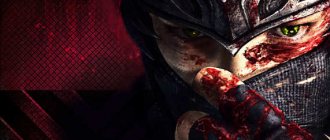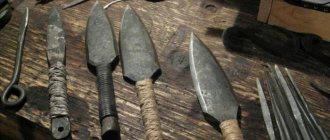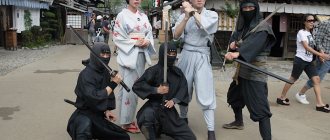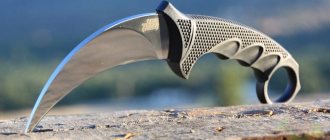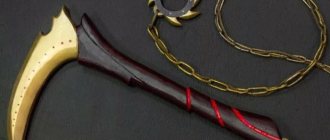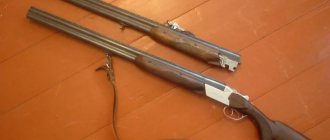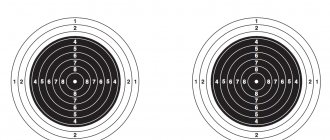Ninjas are mysterious ghosts lurking in the shadows. They are able to sneak into the most protected stronghold to deal a fatal blow to the enemy. The skills of these elusive mercenaries instilled fear and awe in people, giving them the image of terrifying demons of the night. Today, everyone knows about silent killers - children play ninjas, hundreds of films are made about them, and cartoons are created. The image of a man in dark clothes throwing shurikens and running along walls is firmly entrenched in the public consciousness. Therefore, today it is difficult to say what ninjas really were, what is the truth and what is just a beautiful story.
Yamabushi
The world owes the appearance of the first ninjas to hermit monks who lived in the mountains. They professed the Shingon branch of Buddhism and called themselves Yamabushi. These people had exceptional knowledge about man and nature. They were masters of herbal medicine and making poisons; they could both heal diseases and kill. The Yamabushi were also experts in acupuncture and had abilities that far exceeded those of an ordinary person.
The Yamabushi tempered themselves with grueling training, as they believed that the body was an excellent tool for cultivating the spirit. Peasants loved and respected these mysterious hermits, as they could heal illnesses of people and animals, save crops and, as legends say, even controlled the weather. Yamabushi's knowledge of the natural sciences was significantly ahead of their time - they were well versed in astronomy, chemistry, botany, and medicine, which only strengthened the belief in their superhuman abilities.
The emergence of the first ninjas
Over time, the merciless training of the hermits began to bear fruit - they learned to masterfully control their body and mind. Yamabushi could consciously control not only their breathing, but also their pulse. The monastic settlements began to attract people who had not found a place for themselves in society. Among them were also ronins who skillfully wielded swords and other types of weapons. They contributed to the practices that the hermits practiced.
The fact that these people lived among the wild made them masters of camouflage and also gave them the ability to wait. After all, in the mountains there was no rush and bustle, so common in the rest of the world. This endowed the predecessors of the ninja with limitless patience and qualities of character that were inaccessible to the common man. They could survive confidently in the wild and instantly disappear into the natural landscape. Such outstanding achievements attracted those in power to Yamabushi, who wanted to use their unique skills for their own purposes.
Ninja training
What did the legendary shadow warriors do? Often their activities were much more prosaic than shown in films and books. Ninja techniques allowed them to play any role. It was almost impossible to meet one of them in classic black clothes that hid their faces. The ninja always suited the environment in which he had to work. If he was in the company of samurai, then he behaved like a samurai and was dressed accordingly. Among the peasants and beggars, he was dressed in rags. The acting of such a spy was so skillful that it could deceive even the most cunning enemy. Often the ninja's work was carried out so quietly and smoothly that it was impossible to even know that he was there.
Contrary to stereotypical opinion, these geniuses of camouflage rarely participated in contract killings. They were mainly engaged in reconnaissance, obtaining secret information and carrying out sabotage in the enemy camp. That is, ninjas were an analogue of James Bond, and not ruthless hired killers, although, apparently, they were also attracted to such activities, since they perfectly mastered hand-to-hand combat techniques.
NINJA HAND-HAND COMBAT
Defeat the situation, not the enemy. Direct combat with the enemy was not at all the intention of the skilled agent. The enemy was eliminated if the interests of the case required it, and also when he clearly interfered with the plans of the ninja. A competently carried out operation should not have left behind any incriminating traces, except in cases where attention was specifically focused on such traces in order to sow the desired thoughts and moods in the minds of enemies. The opponent was most often perceived only as an animated obstacle, but not as an object of action. To win is to complete the assigned task, and not to finish off a living obstacle that has arisen along the way.
Rationality. All actions of the spy were subordinated to one goal and had to be strictly rational. Why waste energy fighting an enemy when you can simply blind him and escape? Why sneak up on a sentry through the rustling grass, risking every second, if you can silently shoot him with a poisonous needle from a blowpipe? Why get involved in a group fight when it’s easier to misdirect your pursuers? It was considered very advisable to use special weapons and devices that made it possible to neutralize the enemy even before he came into direct contact with the spy.
In addition to special tools and devices, ninjas widely used any objects that came to hand. The ability to use improvised means greatly facilitates the implementation of many techniques: for example, strangulation with a stick is much faster and more effective than strangulation with hands, and a blow with a stone is more powerful than a blow with an empty fist.
In combat conditions, all the capabilities of a well-trained body were realized - from striking to escaping from a restraining grip through an acrobatic trick.
Each action taken must immediately follow from the previous one. It is absolutely unacceptable to be captured if you have not yet decided what you will do in the future. Techniques are performed only to the extent that they correspond to the desired result. No more, no less. If this is achieved at the very beginning of the treatment, there is no point in continuing.
Surprise. Since the ninja usually faced professionals who were fluent in weapons (sword, spear, etc.), victory had to be achieved by unconventional tactics, mixed with surprise and putting the enemy in an unusual combat situation. The most common stunning actions were surprise and suddenness of the attack, closely related to invisibility or lulling the enemy's vigilance with his appearance and behavior; unpredictable changes (“breaking”) of the distance; instant shutdowns (blinding, deafening) or deception (false noise) of the senses; using standard weapons in an unusual manner and using weapons unfamiliar to the enemy (for example, spiked gloves).
Use of the setting. Thanks to becoming accustomed to the theory of the five elements, which we discussed earlier, the scout became a natural part of the environment, and therefore could use it as his own body. This included, for example, periodic disappearances during battle on the ground, and taking advantage of the features of the combat area (altitude difference, type of surface), and using details of the situation as a weapon or a barrier between oneself and the enemy. By relying on weather conditions, it was possible to expose the enemy to the blinding sun, to adjust the decisive technique to the moment the moon sets behind a cloud, to lure the enemy onto a slippery surface in the rain.
Linking the fighting style to the characteristics of the enemy. In the event of a direct confrontation, the scout was confronted by a wide variety of opponents, each of whom had his own level of skill, personal life attitudes, and his own strengths and weaknesses.
The enemy's capabilities and vulnerabilities could be assessed based on many factors. By appearance, involuntary movements and face it was determined which points of the fighter’s body were the most vulnerable, by his physique it was assumed in which fighting techniques the enemy was undoubtedly dangerous, and by his manner of movement his place in the system of primary elements (elements) was recognized, on the basis of which his option was chosen duel. The transition to one or another type of “elemental combat” had to occur reflexively, as a reaction to a subconscious assessment of the enemy and external conditions (for example, a fight in a narrow space was not suitable for the wind style, and a meeting with a timid fighter clearly corresponded to the fire style). The creation of the necessary reflexes was facilitated by the strict discipline of a training fight, reinforced in a sleepy state, followed by a conscious rejection of any constraining rules.
Anonymity. In any of his actions, the ninja was obliged to remain unrecognized. Identifying him could jeopardize contactees and decipher past and future actions of the clan. In combat conditions, such anonymity was ensured by working in invisibility and a specific hood mask that left only the eyes open. When improvising, you can use a scarf or some kind of stretchable fabric tube (stocking, piece of sweater) for this. Making identification difficult, the mask also eliminates unmasking reflections of the facial skin and muffles breathing noise.
Today, a certain degree of unrecognizability can be ensured by completely legal black glasses, which, in addition, save you from fraud with powder or liquid blinders, do not allow the enemy to detect the direction of the fighter’s gaze, prevent you from reading the thought expressed in his eyes or, by the constriction of the pupils, from predicting the beginning of a decisive attacks.
In the Middle Ages, ninjas used special masks and fire tricks, acting as demons (onibi-no-jutsu), frightening superstitious enemies.
Invisibility and silence. A characteristic feature of the spy's combat was his desire to remain invisible during attack or defense. It's hard to fight someone you can't see; Moreover, the feeling that at any moment you could be attacked in an unknown way and from where, puts pressure on the psyche and throws you off balance. Most invisibility tricks were based on two fundamental areas: physical and mental. The first implied that the fighter was positioned outside the enemy’s field of vision; the second is that the ninja is physically in front of the enemy’s eyes, but the latter’s consciousness simply does not perceive him. The second type includes camouflage and imitation invisibility, as well as its more complicated - suggestible and bewitching - variants.
Physical invisibility also has several modifications. Firstly, you can constantly escape from the enemy’s field of vision, using advanced movements or nearby objects. Secondly, operate in an environment where the enemy’s visual sensitivity is significantly reduced (at night, in the early morning fog, in a smoke screen). And finally, you can simply turn off your enemy’s vision by throwing corrosive powder in his face, blinding him at night with a bright flash of fire, poking his fingers in his eyes, or flicking the tip of his nose upward.
A characteristic tactic of a spy who finds himself in the enemy's line of sight is the desire to disappear from his field of vision. Using the features of the environment and relief, this can be done, for example, by unexpectedly leaving (sometimes with a fall) to the ground, a sharp grouping (shortening the frontal plane of the pose) followed by a roll to the side or an instant pass behind the back in combination with a short distraction of the enemy’s attention in another direction .
In some cases, instead of going behind the opponent's back, he himself is turned back to himself, using, for example, such well-known techniques as twisting the head with the hands or turning the torso while grabbing the shoulders. Avoiding the enemy's visual control makes your further actions dangerous and unpredictable for him. Now you can easily carry out a choke that disables a blow to the kidney or spine, or, making a pinning grip, use the enemy as an improvised object when defending against several attackers
An integral part of invisibility is silence. Silent movements ensure the surprise of an attack, and therefore the speed of neutralizing the enemy. In a battle with limited vision (at night, when blinded), the enemy is mainly guided by hearing, and the complete silence of what is happening (or disorienting deceptive noises) causes mental stress and makes him a toy in the hands of the attacker.
Silence of movements is achieved through constant, routine training. First of all, it is necessary to identify and eliminate “own” noises, the noise of untrained breathing, the shuffling of legs when walking, the knocking of the body when falling, etc. When performing combat movements, you should analyze and understand why they make noise, and then try to neutralize these reasons.
Another source of noise is ill-fitting uniforms, shoes, metal objects clinking in clothing, etc.
When maneuvering in the combat space, you should not step on rustling or brittle objects, touch unstable structures, or hit stationary objects. Dexterity and prudence, a trained memory for the situation, and masking possible clumsiness with extraneous noise save you from such troubles.
A very dangerous source of noise for a ninja is a person who discovers it and tries to raise the alarm. To prevent this, a dubious enemy is usually sharply bent back with his head and struck in the throat with the edge of his palm.
Preparing for hand-to-hand combat. There are two main ways to prepare for hand-to-hand combat, which are fundamentally different. The first of them is based on the selection of a certain set of technical techniques that best suit the capabilities of a given person. Then mastery of these techniques is brought to the level of mastery. Situations that arise in battle are then adjusted to suit the chosen techniques. This is a way of formalizing technology, reducing it to certain templates. Its concentrated expression is a set of standard technical actions, known under the names “kata” and “taolu”.
And there is a second method, based on spontaneous movements of the body, automatically reacting to any emerging situation. This is a way of improvisation. It is based on the idea that any pre-worked techniques (templates) deprive a person of the freedom of action that is so necessary in a real, not a game, fight. The ninja relied on the second of these methods, which they called “elemental combat.” They meant that the specificity of improvisations in each specific case is determined by mutual transitions, the interrelation of the five natural elements - earth, water, fire, wind and emptiness.
The first of these methods is the most common. This is evidenced, in particular, by the fact that even in the schools of modern ninjutsu, elemental combat most often means the same sets of specific techniques, only performed in a certain manner. However, this is a profanation that has nothing to do with the true battle of the elements. It is based on special mental states that dictate technical actions without any participation of consciousness. You must not play in the element, but be the element. Moreover, the reincarnation should become so convincing
Noble, so that even the enemy involuntarily believes in the image imposed on him.
Preparation for improvisational ninja hand-to-hand combat involves four main aspects:
Firstly, it is necessary to thoroughly study all places of the human body that are vulnerable to pain and traumatic effects;
Secondly, it is necessary to master an effective technique for influencing these places with targeted blows, finger pressure, and levers on the joints;
Thirdly, you need to achieve perfect control of your body. We are talking about practicing slopes and turns, falls and jumps, rolls and somersaults, wheels and flasks, liberation from restraining grips, interfering clothing, ropes and shackles;
Fourthly, you should learn to use all five natural elements in such a way that they actually determine the necessary program of action, set it into motion and provide the body with a sufficient amount of energy.
The first three aspects are traditional in nature. There is nothing to explain here, except to say what kind of combat equipment the ninja used. This was a technique of Japanese jujutsu, better known in our country under the distorted name jujutsu. The fourth aspect mentioned cannot be understood without an explanation of ninja combat magic (see part 3).
Training methods in taijutsu differ from those adopted in Chinese kempo or Japanese jujutsu. There is no room for practicing air strikes or shadow boxing. From the very beginning, the blows are aimed at the real target - a bag of rags or sand, trees tied with straw, powerful boulders, rotating and hanging mannequins depicting a full-length samurai with a weapon. Plus, working with a partner to learn throws, painful moves, counterattacks, etc.
As mentioned above, there is no kata in taijutsu, at least in the sense that karate followers put into this word (i.e., in the form of a set of certain technical actions arranged according to a certain scheme by the creator of this kata). By systematically practicing such complexes, the student sooner or later finds himself programmed by them, his consciousness no longer goes beyond their framework. The complex begins to force a person to work in the style that is fixed in him. From a ninja's point of view, this is good for dynamic meditation, but not at all suitable for real hand-to-hand combat.
Those kata used in taijutsu are divided into two groups. Firstly, these are purely educational complexes that combine similar techniques. For example, a complex of jumps and somersaults with rolls (kaiten no kamae), a complex of basic punches (dakentai no kamae). They are intended only to facilitate the process of practicing the studied movements to the point of automaticity. Such educational complexes are permissible only in the early stages of training. They are like scales in music, creating, like them, a solid foundation for subsequent improvisations.
Secondly, these are kata of psychological states that do not have a specific technical interpretation (where to turn, where to crouch, what and when to strike). Psychological states determine one or another manner of combat, its strategy and tactics, from which technology naturally follows. In ninpo taijutsu there are five main states of consciousness corresponding to the five primary elements - earth, water, fire, air and emptiness. The platforms for launching certain programs of action in battle are the proper starting positions. For example, shizen no kamae is the position of earth, ichi-monden no kamae is the position of water, jumonden no kamae is the position of fire, etc. The “key” for launching specific programs (i.e. specific tactics) are mental images , symbolizing these primary elements.
One possible image of Earth's battle is a mighty avalanche (ninja) caused by a random small stone (enemy). In this case, the scout demonstrates absolute confidence in himself and in his abilities. The enemy will be crushed, crushed, demolished by a powerful counterattack, no matter how hard he tries to resist his inevitable death. The Fight of Fire ensured success in a fight with an insufficiently experienced or cowardly opponent. He was suppressed by pressure, a cascade of straightforward attacks “head-on”. The fight of Water, on the contrary, was opposed to an enemy who acted in a similar manner. It was characterized by withdrawals back and to the sides, followed by counterattacks that resembled waves, over and over again rolling onto the cliffs of the impregnable shore. The Wind fight was suitable for fights with a skilled and strong opponent. It was dominated by feints, sudden disappearances from the field of view (for example, a sharp sag down, jumping, somersaulting) and circular movements with blows, throws, and painful effects on the joints. The image of a typhoon, sucking in and breaking everything in its path, suits the Battle of Wind well...
To perfectly master all aspects of elemental combat, a certain predisposition is required. In addition, a very important condition is the ability to think creatively. If there are difficulties in imagining pictures of nature, rich colors, various figures, then it is hardly worth wasting time on the energy of the elements. The lack of the ability to feel the movement of energy within oneself along the channels and meridians is also an obstacle. In addition, it is stupid to practice the combat of the elements if the body is “tight”, if a person is not completely healthy, if he does not have the developed habit of practicing sitting meditation every day.
It must be said frankly that today very, very few people can master improvisational elemental combat, as well as any other mystical ninja technique (for example, kuji-goshin-ho). The gap between modern
Menu is a Westerner and a member of a secret clan in medieval Japan. Therefore, most contemporaries and compatriots are better off not wasting time and energy trying to master the combat magic of shadow warriors. It should be understood that their destiny is less exotic, but more accessible and simple hand-to-hand combat systems.
The study of any technique in taijutsu can be divided into four stages.
The first is “getting used to weapons.” Just as a samurai, armed with a sword, draws it from its sheath, tests the sharpness of the blade, weighs it in his hand, makes several swings in the air, and then begins to chop vines and straw targets, so a ninja must get used to any technique he learns, make it his own . Mastering, for example, a punch, he first chooses the most convenient way for himself to form a fist, tries different trajectories of striking with it. The main goal of this stage is to achieve natural, relaxed movements.
The second stage is “unification of movements.” We are talking about combining specific strikes, grabs, throws with movements of the legs and the whole body. We must learn to correctly distribute weight and apply force, while moving at different angles forward, backward, to the side, moving in a circle, rotating in one place. The main thing here is the consistency of the techniques.
The third stage is the “practical use of the technique.” The ninja learns to perform strikes, throws, knocking movements, dodges in various positions, reflecting various types of attacks, playing out some situations in the forest, on the roof, in a narrow corridor, etc. Here you can learn something only together with a partner. The main goal is to understand the true meaning of the technique being studied, to bring its execution to automaticity, regardless of the conditions of use.
Finally, the last stage. It is called the stage of “absolute effectiveness of the intake.” During it, additional
Master the technique to such a degree of perfection that it works intuitively, without the participation of consciousness, on “autopilot”. The connection of the body’s energy, supernatural qualities of the psyche (if any) occurs at this stage.
Combat with weapons in hands was built (and practiced) according to the same schemes. But, unlike his samurai opponents, the ninja avoided any restrictions in such a battle. He used everything that could bring victory. So, in parallel with weapons, legs, distracting tricks, additional weapons (for example, a staff plus a throwing knife) and even hypnosis were used. In any case, the nature of the battle was determined by the characteristics of the situation and the enemy. Ninjas did not recognize any dogmas, any frozen patterns.
Purely technical ninja hand-to-hand combat (taijutsu) included concentrated strikes with limbs on the most vulnerable places of the human body (daken-taijutsu), and bone-crushing grabs, throws, painful effects (ju-taijutsu). Hand-to-hand combat techniques also included various dodges (kawashi), falls (ukemi), somersaults with rolls (kaiten), wheels (daisharin) and jumps (tobi). Slopes provoked enemies to attack past and open up, falls and jumps broke the usual rhythm of battle for the fencer, rolls and somersaults made it possible to unexpectedly disappear from the enemy’s field of view, change the distance, and evade an attack.
Ninja hand-to-hand combat has always been an improvisation based on a certain state of consciousness. However, he was subject to several essential principles. The FIRST of them says: “Achieving maximum results with minimal means” (Ying-shin tonkei). It was he who determined all the strategic, tactical and technical features of the actions of the shadow warriors.
In relation to hand-to-hand combat, this principle was expressed in the following idea: to win at all costs,
Choosing the most rational means of achieving victory. This means that it is necessary to make maximum use of various tricks and tricks, attack the enemy as unexpectedly as possible, from behind or from the side, and not give him the opportunity to deliver a full blow. For example, distract his attention for a moment with your scream, or throw a handful of blinding powder, a lump of earth, or some object at hand in his face. The battle is best waged in conditions of poor visibility - at night, in smoke, fog, in a dark room, making the most of your ability to fight in such an environment.
The best methods of defeat are those that work regardless of the mass and physical power of the enemy. For example, blows to the throat, eyes, temple, groin, collarbones and spine, painful effects on the fingers, hands, nose, genitals, etc. To a fighter using one type of technical action (for example, only sword strikes or grabs with throws and painful holds) should be contrasted with tactics that are unusual for him - sudden departures from the line of attack, kicks at the lower level, somersaults, throwing needles, stars, knives, stones...
All of the above, taken together, led to the fact that it was difficult for the samurai, these constant enemies of the ninja, to predict their style of combat. In turn, the uncertainty of the situation deprived the “bushi” of self-confidence, slowed down the reaction, and reduced the speed and accuracy of the techniques. However, the principle of “in-shin tonkei” can be automatically embodied in all cases, without exception, only when it becomes the principle of all life: in work, in relationships with other people, in the practice of martial arts.
The SECOND most important principle is the preference for method (waza) as opposed to form (kata). If in “kata” the emphasis is on the correspondence of the movements being practiced to certain given patterns, then in “waza” everything is determined by the effectiveness of certain movements in each
House specific case. During the learning process, the student is shown only a general diagram of various techniques, and he must find the most convenient ways of performing them that work for him, not a formal example (“the only way is correct”). This method is more labor-intensive compared to kata, but the skills once developed are not lost over time. After all, they are based on the biomechanical capabilities of this person, and not a master who lived fifty or a hundred years ago.
Therefore, it cannot be said that this or that technique is performed only in the way that the instructor shows. It all depends on the personal qualities and capabilities of the student. Taijutsu requires an independent search for the most rational, economical and effective ways to perform various techniques. This principle is revealed in the following four postulates: naturalness, fluidity, rhythm, distance.
The naturalness of movements (shizen) ensures relaxedness, freedom, confidence in battle, and the absence of excessive tension in the psyche and muscles. To make fighting techniques natural, a person needs to turn them into something as familiar as, for example, moving a hand with a piece of bread to your mouth. This requires a huge amount of repetition of the techniques being learned. Consequently, only by turning your entire life into continuous training, and the world around you into your “dojo”, can you achieve true naturalness of your own actions. It should be recalled in this regard that the life of a boy, teenager, youth, adult man in any ninja clan was, in essence, such training.
Fluidity of movements (nogare) means a smooth transition of one technique to another, which forms a continuous chain of attacking and defensive actions without the slightest pause between them.
For example, a blocking movement turns into a grab, a grab turns into a throw, a throw turns into a blow, a hit turns into strangulation or a fracture of the cervical vertebrae, etc.
Ninja's "natural weapons": fist, fingers, palm
You should not try to necessarily complete every technique, regardless of changes in the battle situation. Now the enemy has captured your hand. To release the grip, you use leverage on his hand outward. However, before you could perform this technique, the enemy released you. But this was precisely your goal. It makes sense to immediately strike with the freed hand, and then act according to the situation. Ensuring fluidity in battle is possible due to the variety of mastered techniques, combined with mental and physical looseness.
The concept of rhythm (ritsudo) comes down to the fact that any fight represents the alternation of certain movements (those elements that make up techniques, movements, deviations) with a certain frequency. A sense of rhythm allows you to win the initiative, since having started to act at one pace or another, a person maintains it for some time, at least a second or two. By adjusting to the enemy’s rhythm and then suddenly speeding up or slowing down your movements, you can “interfere” with his actions. Or simply impose your own rhythm on the enemy. We can also say that the sense of rhythm determines the timeliness of using various techniques. For example, there is no need to avoid a strike that has not yet begun or to block when the strike has already been carried out.
The requirement to “keep your distance” (ma-ay) is caused by the need to be at any moment of the battle where the enemy will not reach you, or will reach you with minimal damage. You should be able to attack him for sure. This requirement also means that you should not waste your energy in vain, attacking from the wrong distance, since the attack will inevitably “fail” into the void or, even worse, expose you to a counter attack. Choosing the correct distance is impossible without a good eye, the so-called “sense of the enemy” and the ability to mix. All of these components can only be developed through practice. No meditation will help here.
The THIRD principle of taijutsu is formulated as follows: “Body and weapon are one” (kentai-ichiyo).
This statement has a slightly different meaning than another well-known thesis - “weapons are an extension of the body.” In ninjutsu, the emphasis is on the fact that the body itself is a weapon, while any mechanical device (weapon) serves only as an auxiliary means to enhance the damaging effects of body movements. A ninja hits with a fist or brass knuckles, throws a star or a knife, works with a kyoketsu-shoge or a staff, nothing changes. The state of consciousness, basic principles, the nature of movements and slopes, vectors of application of force, energy consumption - everything remains unchanged.
Treating the body as a weapon involves meeting several requirements. The first of them sounds like this: “a strike from any position.” The hand, foot, elbow, knee, finger begin their journey from there and then, where and when it is required. No unnecessary movements such as swinging, bringing the fist to the hip, preliminary extension of the leg, twisting the body, etc.
The second requirement: in real mortal combat there is no place for apparently impressive, but actually harmless movements. Any blow must go to a specific point of destruction, and not to the abstract “middle” or “upper” level. In addition, each blow must be delivered with a minimal impact surface (finger, one of the sides of a clenched fist, elbow, edge of the foot), which provides a powerful destructive wave inside the body.
The next requirement comes down to the refusal of rigid fixation of the feet, hips and shoulders. For example, a strike with the fist (or the heel of the palm) must occur a fraction of a second earlier before the foot moving at that moment becomes firmly on the ground. As a result, the kinetic energy of the body, legs and striking arm is combined in a single vector of force, directed forward a few moments after contact with the target. If you sharply remove the hit-
By pinching your arm (or leg), you will create a powerful shock wave that will cause severe internal damage.
Another requirement was called “block and strike - one whole” (uke-kime-itiyo). It implies that parry and counterstrike must merge into one action. No isolated hard blocks like karate “age-uke” and “gedan-barai”. A block in taijutsu is actually a stopping blow to a point located on the attacking limb of the enemy. And in many cases, he also continues his counter movement until he touches the opponent’s body or head...
Who were the ninjas
To be a skilled mercenary, a ninja had to rebuild his entire life. Therefore, they did not occupy a specific place in the Japanese hierarchy, but were outside it. In the ranks of ninjas one could meet representatives of any class. Movies often show a confrontation between samurai and spies dressed in dark clothes. But in fact, the main customers of the ninja were the samurai, who constantly fought among themselves. Moreover, if one of them went bankrupt, he often moved to one of the ninja clans, where samurai fighting techniques came in handy.
There were also commoners in such clans. However, there is no evidence that they stood up for the peasants and protected them from the samurai. Most likely, these are just beautiful legends that romanticize the image of the ninja. It is important to understand that the warriors of the night were mercenaries and did any work for which they were willing to pay. That is, the decisive factor in the life of their clans was money, and not moral values and beliefs. Whoever pays the most will be helped. Therefore, ninja techniques were aimed more at espionage and obtaining secret information than at eliminating the enemy.
Secrets of Ninjutsu
Yoshimori hyaku-shu
Yoshimori Hyaku-shu (One Hundred Poems of Yoshimori) is considered the oldest manual on ninjutsu. These poems, in the tanka genre (that is, 5-7-5-7-7 syllables), are attributed to Ise no Saburo Yoshimori, an associate of the famous commander Minamoto no Yoshitsune. For a long time they were passed from teacher to student as kuden and learned by heart. Then, already at the beginning of the 17th century, they received a written record.
At the moment, historians do not know for sure whether Yoshimori is the author of these tanka, or whether they were attributed to him to give them greater authority, and were compiled later than the Kamakura era (1185-1333). In any case, these poems first appeared in 1612 in “Gumpo jiyoshu” (“Collection of the ways in which samurai use the art of war”), a military treatise by Ogasawara Sakuun Katsudzo, in the chapter “Yoshimori hyakushu no koto” (“On Yoshimori’s Hundred Poems” ). Then, with some variations, these poems are repeated in Fujibayashi Yasutake's ten-volume work "Bansenshukai" ("Ten Thousand Rivers Flowing into the Sea"), written in 1676. In "Bansenshukai" these poems are called "Poems of Yoshimori", "100 Poems of the Ninja " and "Shinobi-uta". But the Bansenshukai does not contain all one hundred poems, but only forty-nine.
Migita Toshihide (1863-1925) Ise no Saburo Yoshimori
Little information has been preserved about Yoshimori’s life, and all of it is extremely contradictory. Perhaps this is because Yoshimori has long been a popular character in Japanese folklore, and now it is no longer possible to separate Yoshimori, as a real historical figure, from the legendary image created by wandering storytellers. According to The Tale of Yoshitsune, the meeting between Yoshimori and Minamoto no Yoshitsune occurred when the latter fled from the Kurama-dera monastery, where he had been fostered, and headed to the region of Oshu under the protection of a longtime supporter of the Minamoto clan, Fujiwara no Hidehira. On the way, he stopped for the night in a small village in the province of Kozuke, where he received shelter in the house of Yoshimori. The owner of the house, despite his stern character, greeted the traveler quite cordially and even treated him to wine. After listening to Yoshitsune's story and learning that he was the son of Minamoto no Yoshitomo, Yoshimori was delighted, saying that his father was a vassal of Yoshitomo, and he himself hated Taira and was ready to serve the Minamoto clan. “The Tale of Yoshitsune” conveys the following story of Yoshimori about himself:
“My parent formerly lived in the province of Ise on the banks of the Futami. His name was Ise no Kanrai Yoshitsura, and he was a priest in the Great Temples of Ise. One day, he went to worship at the capital's Kiyomizu Temple - Pure Moisture, and on the way back he met a man named Saint from Ninth Avenue. This man did not dismount in front of him to greet him, and his father hacked him to death and exposed his head on the bank of the Kamo River. For such guilt, he was exiled to these parts to Nagashima, in the province of Kozuke. As time passed, wanting to forget his native place, he got married and died here unforgiven, leaving his wife in the seventh month. When I was born, this woman, my mother, decided to abandon me, considering that I was unhappy due to sins in my past life, which is why I lost my parent in her womb. But my uncle, one of her brothers, took pity on me, took me in and raised me, and as soon as I turned thirteen, he began to prepare me for the ritual of my first male hairstyle. Then I asked my mother: “What kind of person was my parent?” She burst into tears and did not answer immediately. “Your parent,” she said, “comes from the shores of Futami Bay in the land of Ise. He was exiled to us in the Eastern lands, and his name was Ise no Kanrai Yoshitsura. In his homeland, he was sought out by the high favor of the excellent equerry of the left side, but an unexpected misfortune happened, and he ended up in these parts. Here he conceived you and died seven months later.” Just as my parent’s name was Ise no Kanrai, so I am called Ise no Saburo. Just as my parent’s name was Yoshitsura, so is my name Yoshimori.”
However, there is another version of Yoshimori’s biography. Okuse Heishichiro believes that his real name was Koroku, and he was the leader of the bandits from Mount Kabutoyama in Iga, where he was from. He studied the art of military strategy of the Kyohachi-ryu school, and was well versed in the tactics of guerrilla warfare, which he successfully used during his raids and in clashes with government troops. When the War of Genpei no Ran (1180-1185) began between the two influential clans of Minamoto and Taira, Yoshimori took the side of Minamoto, becoming a loyal vassal of Minamoto no Yoshitsune.
Yoshimori's poems are devoted to various aspects of ninjutsu: moral and ethical training, mystical fortune-telling practices, military reconnaissance, night patrols, camouflage and secret penetration into enemy castles and military camps. If desired, these poems can even be divided into thematic cycles, but in both “Gumpo jiyoshu” and “Bansenshukai” their order is somewhat chaotic: poems devoted to methods of camouflage and night attacks are interspersed with poems devoted to the general principles of military strategy and moral and ethical issues. So many poems talk about the use of ninjas by warlords. Sometimes it seems that they were written not so much for ordinary ninjas themselves, but for high-ranking samurai, strategists and generals. If we accept the version of the early origin of these poems and the authorship of Yoshimori, then we have a very valuable source on the early period of the history of ninjutsu, and, comparing “Yoshimori Hyaku-shu” with later instructions, we can see what path this art has taken in its development .
The times of the ninja
It is believed that ninja clans were finally formed around the 10th century AD. In those days, nobles used their services to resolve their conflicts. The secret techniques of the ninja were ideal for gaining an advantage in the struggle for power. Shinobi services were especially popular during the unification of Japan. This happened approximately 1460-1600. Then all parties to the conflict used the services of ninjas in order to gain at least some advantage in this monstrous war.
However, in subsequent years, the Tokugawa shogun decided that it was too dangerous to abandon the freedom-loving clans. Moreover, since ninjas were mercenaries who served those who paid well, their services could be used against him, which was not at all part of the plans of the ambitious shogun. As a result, he pitted the two largest clans against each other - Iga and Koga. The bloody confrontation between them ended with most of the ninja being destroyed. The survivors were weak and scattered, forcing them to swear allegiance to the Tokugawa.
Shinobi and war
Movies often show hordes of ninjas storming a fortress or fighting samurai. However, it was illogical for the warriors of the night to engage in direct confrontation. Ninja combat techniques were designed for quietly eliminating a target or waging a guerrilla war, but certainly not for confronting the enemy in an open field. Of course, a direct collision left no chance for the mysterious saboteurs. But they were competent strategists and did not allow the war to be waged according to the rules of the enemy. But their help could have a decisive influence on the outcome of the war, since a ninja who penetrated the enemy’s fortress could make a lot of noise, cause sabotage and demoralize the enemy.
Masters of camouflage could penetrate the enemy's camp both in peacetime and during large-scale hostilities. Their targets were military leaders or strategic targets. Also, the information that these fearless spies obtained could provide their employer with a decisive advantage and change the outcome of the war.
Shurikens are terrible weapons
Everyone knows that ninjas love shurikens—throwing projectiles that resemble stars. In films, shinobi throw them with such force that they break through walls, pierce through enemies in modern body armor, and even amputate limbs of opponents! This is what the secret techniques of ninjutsu mean.
In fact, even an extremely strong person cannot throw a shuriken so as to cut off an enemy’s leg.
Unless, of course, he has a prosthetic arm with a built-in spring shuriken thrower, like the main character of the game Sekiro: Shadows Die Twice. But it’s unlikely that real shinobi had such technology.
Screenshot from the game Sekiro: Shadows Die Twice
Shurikens have never been the main weapon of ninjas, since it is very difficult to kill a person with such a thing. More often they were used by Classical Weaponry of Japan: Special Weapons and Tactics of the Martial Arts to disorient the enemy: a couple of them fly into your face, you instinctively turn away to save your eyes, and receive a kusari-kama to the skull.
In addition, shurikens have very mediocre ballistics, so they were thrown on the principle of “just hope you hit somewhere.” They were also lubricated by Secrets of the Samurai; A Survey of the Martial Arts of Feudal Japan, Black Belt was poisoned or covered with animal feces, or even with one’s own feces, to increase the chance of blood poisoning in the enemy when wounded. By the way, doing the same thing, for example, with bamboo spears, was also not forbidden.
Often, shurikens would also be buried in the ground for a period of time so that their surface would be covered with Secrets of the Samurai; A Survey of the Martial Arts of Feudal Japan by the anaerobic bacterium Clostridium tetani, which causes tetanus. And then even a scratch from such a shell became dangerous.
Shurikens were not the only ranged weapons. Ninjas also shot Ninja AD 1460–1650 from bows, muskets and arquebuses. They also used bombs and laid mines.
In addition, shurikens did not necessarily look like stars. These could be simply sharpened thin knives, or round throwing missiles, or something similar to coins or chopsticks - such things could easily be carried past the guards.
Photo: Rustedshuriken / Wikimedia Commons
And by the way, shurikens were used in Secrets of the Samurai; A Survey of the Martial Arts of Feudal Japan, not only ninjas, but also samurai - they saw nothing shameful in pelting the enemy with sharp things smeared with all sorts of dirty tricks.
Ninja moves
Today, like mushrooms after rain, all kinds of schools for teaching the art of warriors of the night have popped up. In them, fans of ninja films pose as skilled killers and scouts. However, these people mostly invent ninjutsu techniques in order to get money from gullible students. In general, it is difficult to say that the art of shinobi was as structured and understandable as, for example, karate or judo. There is no evidence that they all used any one technique to achieve their goals. Rather, these were general principles and methods of survival in extreme conditions.
Ninja training resembled that of a special forces soldier rather than the martial arts of Japan. But there are still thousands of enthusiasts throwing shurikens and performing complex acrobatic stunts in stylized black suits. An entire industry has grown up around this activity. Anyone who has firmly decided to become a modern ninja can go to the store and buy himself a suit, shurikens and all kinds of chains. By going online, you can easily purchase a “ninja sword” and become the coolest in the area. How did the training of the warriors of the night actually take place?
Ninja martial arts
Ninjas mastered all types of martial arts known to them.
In hand-to-hand combat (with or without weapons), they used jujutsu (or jujutsu), a martial art based on soft movements.
Samurai, the main partners in fights, also used jujitsu, so ninjas tried to surpass them:
- they made more shots per unit of time.
- We learned to fight in small spaces where we couldn’t make sweeping movements or use long weapons. Therefore, shinobi mastered the technique of choking techniques, short blows, arm twisting, and pressing on pressure points.
- tried to attack suddenly. A surprise attack using hidden weapons was preferable to hand-to-hand combat. Why? For close open combat, a person must have trained certain muscle groups, which will give him the appearance of a “jock” and, accordingly, will set him apart from the general mass of people. And this, as we mentioned above, is undesirable.
- in case of exposure, they tried to discourage the enemy in order to gain time for retreat. For example, a shinobi threw himself at the enemy’s feet, he fell, and at that time the ninja instantly jumped up and ran away.
Structure of clans
Over time, ninja clans became clearly structured and fully formed structures. It was almost impossible for an outsider to get into such a clan. Knowledge was passed on from father to son and carefully guarded from prying eyes. Scrolls with ninjutsu techniques were kept especially jealously; teaching an outsider was punishable by death. Each clan specialized in special techniques unique to it. Some of them were specialists in sabotage, some preferred poisons, and some were fed by insidious ambushes.
There was a clear hierarchy within the shinobi clans. The top was involved in concluding agreements, signing contracts, joining and leaving unions. There was also a middle layer, the purpose of which was to control the execution of orders from above. At the bottom rung of the hierarchical ladder were ordinary performers. That is, ninja clans were serious organizations with strict discipline and a pronounced hierarchy.
Ninja costume
The familiar black suits, by which everyone can recognize a ninja, are more likely a product of cinema than a reflection of the real state of affairs. Black is not the best color for camouflage, as it is extremely rare in nature. Therefore, different shades of brown and gray were most often used. It was they who allowed us to merge with the surrounding world most fully. The notorious ninja sword was also not the favorite weapon of elusive spies. They preferred chains, plows, retractable spears, shurikens and other tools that were easy to hide or pass off as tools of peasant labor.
The shinobi camouflage suit was used infrequently, as in most cases the warriors of the night disguised themselves as their surroundings in order to get to their target in the simplest and most effective way. The ninja suit had many pockets in which medicinal herbs, poisons, needles and shurikens, as well as other combat weapons, were placed.
Ninja clothing and equipment
During the day, ninjas dressed like other people, so as not to stand out from the crowd. And at night they wore loose clothing in muted colors that did not restrict movement. Dark gray, reddish brown, ash - these colors made it possible to be invisible in the dark, which is what the ninjas sought.
Among the means of protection, shinobi wore plates under their clothes to protect the places where the enemy usually hit.
Each ninja was required to carry equipment that he might need during the “operation”:
Kaginawa
Kaginawa
Kaginawa is a hook attached to a cord (it could be used to climb over a wall, cross a pond, tie up an enemy, fish, hunt).
Sekihitsu and Yadate
Sekihitsu
Sekihitsu (stylus), yadate (inkwell with a brush), chalk or charcoal - with their help, ninja wrote down the information they obtained or applied the desired mark.
Sanjaku-tenugui
Sanjaku-tenugui is a towel the color of clothing, tied on a belt or placed in a pocket. If necessary, they could protect the respiratory tract from acrid smoke, tie up an enemy, bandage a wound, filter water, and so on.
Uchidake
Uchidake (tsukedake, hidake) - a container for carrying smoldering coals. As a rule, they were made of bamboo, lined with metal plates on the inside (to avoid fire) and holes were made in the body to allow air to enter. Worn on a cord, tied to a belt.
Casa
Amigasa.
Japanese straw hat Kasa is the national Japanese straw hat. There are a lot of varieties of hats; ninjas chose the right one depending on who they needed to introduce themselves at the moment. As a rule, shinobi chose an amigasa - a samurai hat with a wide brim, under which you can hide both your face and weapons.
Yakukhin
Yakukhin (“first aid kit”) is a small box with herbs and antidotes, hung from the belt.
Specialized weapons
The ninja's arsenal included not only hand-to-hand combat techniques and edged weapons. They also skillfully used hooks, ladders, ropes and other things with which they could get into the palace chambers or overcome the fortress wall. Shinobi also knew a lot about the use of explosives, which helped to sow panic in the enemy’s camp or make a hole in the wall. Ninja shoes were also adapted to perform their tasks.
They often carried special breathing tubes with them. Ninja techniques allowed them to stay under water for a long time, breathing through a thin tube. But the most powerful weapon of these cunning scouts was their knowledge of psychology. They could play any social role, ingratiate themselves with the right person. Ninjas knew how to control their own consciousness, which allowed them to survive the most difficult trials without experiencing discomfort.
Nobunaga Oda
No matter how hard the ninja tried to refrain from direct participation in the war, they failed. Nobunaga Oda, a tough military leader who wanted to unite the country, managed to destroy the Iga clan, the strongest shinobi organization. He left no stone unturned in the area where this powerful clan settled and, as a result of a fierce confrontation, managed to defeat his enemies. The surviving members of the clan scattered across the country. However, this victory was not easy for the brave samurai. Many thousands of soldiers died at the hands of ninjas.
Ninjutsu today
Modern ninjas hardly study Japanese martial arts. They don't run on walls or throw needles. Intelligence agencies have changed their methods of operation significantly over the past centuries. Of course, the training methods used by ancient spies are still relevant today. For example, in special units that need to be able to survive in the wild and fight in the forest. But videos with the titles “Ninja Techniques for Beginners” or various manuals “Ninjutsu for Dummies” are simply a smart commercial move and have nothing to do with the mysterious warriors of the night. However, shinobi and their unique life path are a valuable cultural heritage that should not be lost.
What is ninjutsu
This martial art, like any other that appeared in the East, is based on a certain philosophy. Ninjas were convinced that any human action causes a response from the environment, especially if this action is aggressive. And to avoid this, it is necessary to act secretly, without disturbing the balance of the environment.
Each shinobi mastered three areas of knowledge and skills:
- Tonjutsu is the skills of using improvised means and special devices in battle. It was believed that a ninja is able to connect with the external environment, having learned 5 elements: Earth, Fire, Water, Air and Emptiness. This will allow him to become indistinguishable from what surrounds him, and also to move unnoticed, easily overcome high obstacles, read tracks and defeat the enemy by cunning.
- Fighting skills without weapons and using them. The first group of skills was called taijutsu, and it used jujutsu techniques. The second, bujutsu, implied the use of a sword, naginata, pole and shuriken. Shurikens were small sharp spikes or metal plates designed to be thrown.
- Kenjutsu is also known - Japanese sword fencing. As part of this discipline, through performing exercises (kata) in pairs or alone, ninjas learned to use a sword against any other weapon, and also mastered combat psychology.
- Ninpo-mikke is the use of the body’s internal resources through one’s own consciousness.
